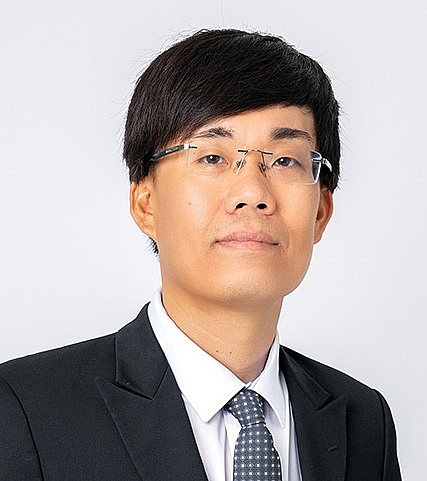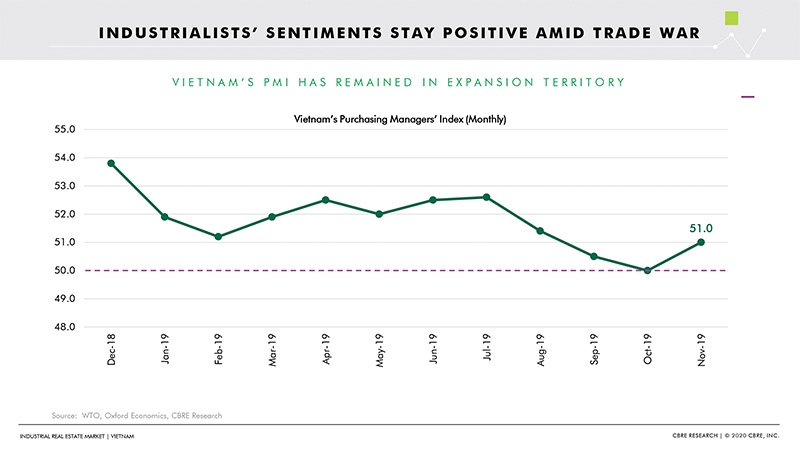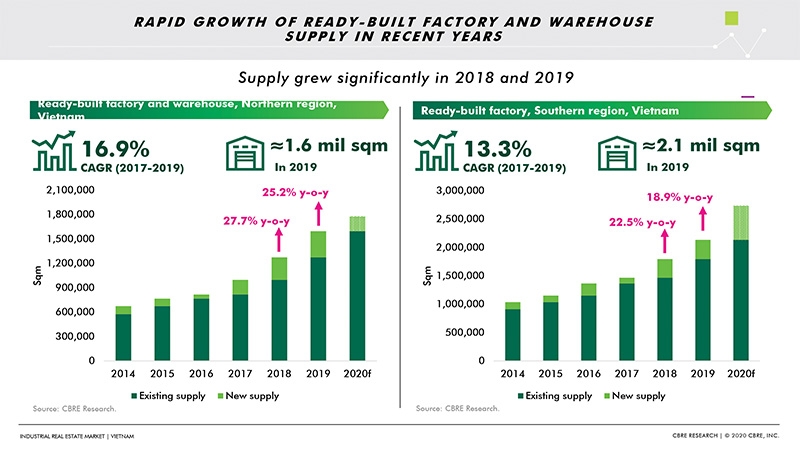 |
|
Hieu Le
|
Amid the rising cost of production in China, businesses began their relocation processes to alternative locations in Southeast Asia, including Vietnam. In fact, a recent surge of demand for setting up production plants in Vietnam has made the country’s industrial property market, which is still dominated by raw land supply, become more vibrant than ever.
Industrial parks (IPs) in major cities and provinces have been rapidly occupied in the context of the surging demand. The average occupancy rates of IPs in major northern and southern cities and provinces were over 92 and 80 per cent, respectively, at the end of 2019. When there is limited vacant land, developers of existing IPs tend to switch to ready-built factories, which are more time and cost-efficient to tenants who prefer a speedy setup.
Over the last two years, significant growth of ready-built factory supplies was observed in major IPs in Vietnam. As of 2019, the southern region of Vietnam, including Ho Chi Minh City, and the provinces of Binh Duong, Dong Nai, and Long An, welcomed about 380,000 square metres of ready-built factory grounds, up by 18.9 per cent on-year. Meanwhile, the new supply of the northern region, including Hanoi, Haiphong, and the provinces of Bac Ninh, Hai Duong, and Hung Yen was 321,000sq.m, up by 25.2 per cent on-year.
The export manufacturing industry has been the backbone of Vietnam’s economy, with notable names such as Samsung, Pou Chen Group, Truong Hai Auto Corporation (THACO), and VinFast which have established their footprints in the industry. The most important impact of their production plants in the country is their forming and developing of related supporting industries and suppliers.
Since the launch of Samsung’s factory in Bac Ninh in 2009, the South Korean giant has not only actively brought its foreign suppliers into Vietnam but also localised its network of Vietnamese vendors rapidly. Currently, there are 210 Vietnamese vendors for Samsung, of which 42 companies are tier-1 suppliers, with most of their factories located within 45 kilometres from Samsung’s main factories in Thai Nguyen, Bac Ninh, and Ho Chi Minh City.
In the automotive industry, Vietnamese private conglomerates, including THACO and Vingroup, are showing ambitious plans in creating their self-developed automotive manufacturing complexes with high-concentrated chain of suppliers. For THACO, the 325-hectare Chu Lai Truong Hai automotive complex in the south-central province of Quang Nam includes a 100ha automotive component IP and has been a successful development case of a domestic player in the automotive market.
Targeting a 40-per-cent localisation rate, THACO partners with experienced foreign suppliers to co-develop more than 11 component manufacturing factories with varying land sizes to not only provide auto parts for its assembling factories but also to export.
Even though VinFast is a newcomer in this industry, it is not an underdog in the competition. To gain a head start by taking a shortcut, Vingroup launched VinFast’s 335ha automotive complex in Haiphong which is the home of the most modern auto and parts manufacturing factories in Vietnam, with 20,000-200,000sq.m large ready-built factories forming a hub for the auto parts production.
 |
 |
In general, the emergence of supporting industry hubs has been widely observed in Vietnam. Either concentrating in an IP or dispersing within a 40km radius from main assembling factories, industrial developers are in a good time to build up ready-built factories focusing on the formation of supporting industries along with application of technology in property management.
Leading developers in the ready-built factory sector such as BW Industrial, KTG Industrial, and An Phat Holdings have already caught chances to welcome a new wave of components manufacturers and suppliers following the relocation trend in recent years. A large proportion of industrial property suppliers, both for land and ready-built factories, are located in major southern and northern cities and provinces (classified as tier-1 areas), with the demand for market performance increasing rapidly. The expansion of supply has been led by the completion of critical infrastructure projects, especially expressways and ports. More competitive land prices as well as lower occupancy rates are making emerging industrial areas in surrounding provinces (classified as tier-2 areas) become more attractive to investors and developers.
Looking forward, there will be an increasing industrial development and investment in tier-2 locations. Most of the large land banks in these areas are agricultural land, which requires the conversion of land use. Therefore, foreign developers and investors are recommended to co-operate with local businesses to smoothen the land acquisition and legal processes.
|
John Campbell - Manager, Industrial Services Savills Vietnam
With Vietnam’s continuous expansion of trade networks of key free trade agreements, there is an even greater demand for industrial property coming from new countries and industries. By enabling the latest production technologies and increasing workforce training, the government is easing qualms around viability, labour shortages, and rising costs. Moving to a more transparent business environment will help mitigate investor concerns and improve quality. More developers are offering ready-built factories and build-to-suit solutions for end-users. Ready-built assets also provide the opportunity for investors and developers to meet the market demand of supporting industries and assembly operators. Stephen Wyatt - Country head, JLL Vietnam
Vietnam has gradually become one of the industrial bright spots of Southeast Asia. We expect the industrial sector to remain hot in the coming time. The lack of high specifications, modern logistics warehouse space, and a strong demand from regional occupiers are supporting the potential growth of this industry. The rapid growth of the middle-income population creates more disposable income and a growing customer base for e-commerce that will put significant demand on logistics facilities. The quality of the assets, rental growth, deal size and remaining land tenures are the crucial factors for investors to determine their investment decisions. VIR
|
Hieu Le (Director Industrial and Logistics Services CBRE Vietnam)

Support industry promotes development of industrial real estate
The supporting industry boosted the development of Việt Nam's industrial real estate market last year, according to CBRE Viet Nam Co, Ltd.

Vietnam's industrial real estate sector heats up
The development of the industrial real estate market will have a positive impact on other market segments such as houses and offices for rent.
 Last year was another record year for industrial and logistics real estate in Vietnam when foreign direct investment (FDI) into manufacturing remained positive.
Last year was another record year for industrial and logistics real estate in Vietnam when foreign direct investment (FDI) into manufacturing remained positive.
